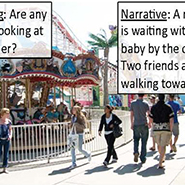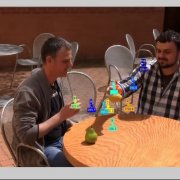Many of the most interesting and salient activities that humans perform involve manipulating objects, which frequently involves using hands to grasp and move objects. Unfortunately, object detectors tend to fail at precisely this critical juncture where the salient part of the activity occurs because the hand occludes the object being grasped. At the same time, while a hand is manipulating an object, the hand is being significantly deformed making it more difficult to recognize. We are addressing both of these problems simultaneously, jointly tracking hands and objects while determining their relationships and the events they participate in.
Vision and Language
 The goal of this research is to combine vision with aspects of language and social cognition to obtain complex knowledge about the environment. To obtain a full understanding of visual scenes, computational models should be able to extract from the scene any meaningful information that a human observer can extract about actions, agents, goals, scenes and object configurations, social interactions, and more. We refer to this as the ‘Turing test for vision,’ i.e., the ability of a machine to use vision to answer a large and flexible set of queries about objects and agents in an image in a human-like manner. Queries might be about objects, their parts, and spatial relations between objects, actions, goals, and interactions. Understanding queries and formulating answers requires interactions between vision and natural language. Interpreting goals and interactions requires connections between vision and social cognition. Answering queries also requires task-dependent processing, i.e., different visual processes to achieve different goals.
The goal of this research is to combine vision with aspects of language and social cognition to obtain complex knowledge about the environment. To obtain a full understanding of visual scenes, computational models should be able to extract from the scene any meaningful information that a human observer can extract about actions, agents, goals, scenes and object configurations, social interactions, and more. We refer to this as the ‘Turing test for vision,’ i.e., the ability of a machine to use vision to answer a large and flexible set of queries about objects and agents in an image in a human-like manner. Queries might be about objects, their parts, and spatial relations between objects, actions, goals, and interactions. Understanding queries and formulating answers requires interactions between vision and natural language. Interpreting goals and interactions requires connections between vision and social cognition. Answering queries also requires task-dependent processing, i.e., different visual processes to achieve different goals.

